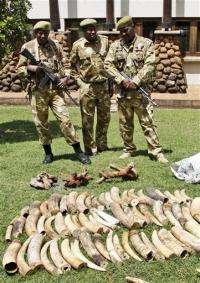Kenya study: Big jump in elephant poaching deaths

A 14-year study of a nearly 1,000 elephants in Kenya shows an alarming death rate among older males—those with large, valuable tusks—and an acceleration in poaching deaths, the group Save The Elephants said Thursday.
The study said that in 2000 the region of Samburu had 38 known elephant males over 30 years of age. But 2011 only five of those original 38 were still alive. Almost half of the known females over 30 years also died during this period, at least half from illegal killings, the study found.
Targeted poaching deaths of Africa's elephants have accelerated in the last several years. The killings are driven by the rising price of ivory as demand increases across Asia—and especially in China—for the rare natural resource.
Animal experts worry that unless China's increasingly wealthy middle class can be educated about how elephants must be killed in order to provide the ivory used to make small, coveted trinkets, the world's elephant population will be in danger of being hunted to extinction.
"Ivory demand and prices have reached a point at which poachers are willing to target well-protected, closely monitored populations," said Iain Douglas-Hamilton, founder of Save The Elephants, in a statement to release the report. "This is now being replicated in other protected areas across Africa."
The new study, published Wednesday in PLOS One, a peer-reviewed online scientific journal, found that the elephants of Samburu appeared to recognize the threat they faced and increased their reproductive rate.
Africa's elephants last faced a threat to their survival in the 1970s and 1980s. But the banning of ivory helped stem the threat until recent years, when the price again began climbing, increasing the incentive for poachers, corrupt government agents and even militant groups to kill elephants for their ivory.
Every week brings new reports of shipping containers full of tons of ivory discovered at ports in Africa or on the receiving end in Asia. Earlier this month a family of 12 elephants was killed in Kenya's largest wildlife park; all their tusks were removed.
Douglas-Hamilton believes the battle has not yet been lost, though.
"We faced this threat 30 years ago and we know that this situation can be controlled and reversed if the appetite for ivory is reduced. There needs to be united action from concerned individuals, NGOs and governments to reduce the demand for ivory," he said.
The study found that 56 percent of elephants in the Samburu region were being killed by poachers during the last three years of the study. In 1998 42 percent of the population was male but that by 2011 the bulls—who carry the most ivory—made up only 32 percent of the population.
Copyright 2013 The Associated Press. All rights reserved. This material may not be published, broadcast, rewritten or redistributed.




















